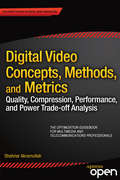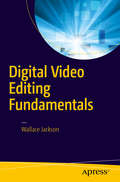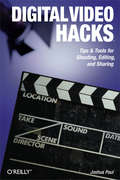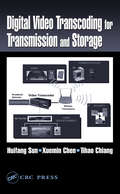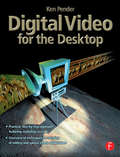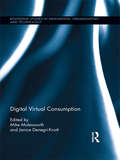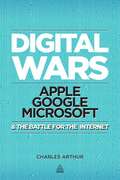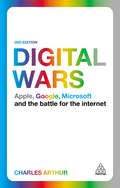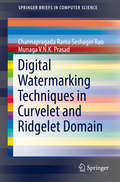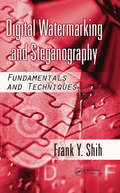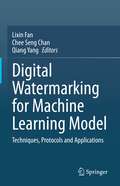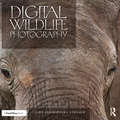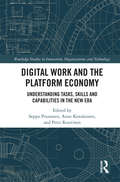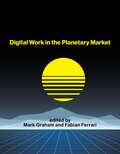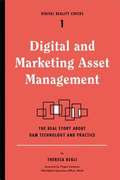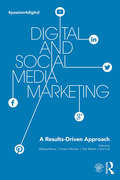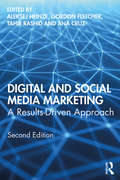- Table View
- List View
Digital Video Concepts, Methods, and Metrics: Quality, Compression, Performance, and Power Trade-off Analysis
by Shahriar AkramullahDigital Video Concepts, Methods, and Metrics: Quality, Compression, Performance, and Power Trade-off Analysis is a concise reference for professionals in a wide range of applications and vocations. It focuses on giving the reader mastery over the concepts, methods and metrics of digital video coding, so that readers have sufficient understanding to choose and tune coding parameters for optimum results that would suit their particular needs for quality, compression, speed and power. The practical aspects are many: Uploading video to the Internet is only the beginning of a trend where a consumer controls video quality and speed by trading off various other factors. Open source and proprietary applications such as video e-mail, private party content generation, editing and archiving, and cloud asset management would give further control to the end-user. Digital video is frequently compressed and coded for easier storage and transmission. This process involves visual quality loss due to typical data compression techniques and requires use of high performance computing systems. A careful balance between the amount of compression, the visual quality loss and the coding speed is necessary to keep the total system cost down, while delivering a good user experience for various video applications. At the same time, power consumption optimizations are also essential to get the job done on inexpensive consumer platforms. Trade-offs can be made among these factors, and relevant considerations are particularly important in resource-constrained low power devices. To better understand the trade-offs this book discusses a comprehensive set of engineering principles, strategies, methods and metrics. It also exposes readers to approaches on how to differentiate and rank video coding solutions. What you'll learn Cost-benefit analysis of compression techniques Video quality metrics evaluation Performance and power optimization and measurement Trade-off analysis among power, performance, and visual quality Emerging uses and applications of video technologies Who this book is for This book is for anyone involved in designing, developing, validating, deploying, and reviewing systems and applications that deal with digital video. For example, software and hardware engineers, system architects, technical program and product managers, support and sales engineers, system integrators, technology journalists and video professionals working in the multimedia and telecommunication industries, researchers and graduate students, or even a tech-savvy user who posts a YouTube video would find this book a useful reference. Table of Contents Foreword/Preface Chapter 1:Introduction Chapter 2: Digital Video Compression Techniques Chapter 3: Video Coding Standards Chapter 4: Video Quality Metrics Chapter 5: Video Coding Speed and Performance Chapter 6: Power Consumptions by Video Applications Chapter 7: Video Application Power Consumption on Low-Power Platforms Chapter 8: Performance, Power, and Quality Tradeoff Analysis Chapter 9: Conclusion Appendix: Related Resources
Digital Video Editing Fundamentals
by Wallace JacksonThis compact visual guide covers concepts central to digital video using the affordable Corel Video Studio Ultimate X9 software package as well as open source digital video editing package Editshare Lightworks 12. Digital Video Editing Fundamentals builds on the essential concepts of digital imaging, audio, illustration, and painting, and gets more advanced as chapters progress, covering what digital video new media formats are best for use with Android Studio, Java and JavaFX, iOS and HTML5. Furthermore, the author covers the key factors regarding the data footprint optimization work process, streaming versus captive assets, and why these are important. What you'll learn What is the terminology of digital video editing and special effects What comprises a digital video editing and effects pipeline What are the concepts behind digital video editing What are the concepts behind Resolution, Aspect Ratio, Bit Rate and Color Depth Pixel editing, color correction, layers, compression are all discussed in some detail How to use digital video file formats and data footprint optimization Who this book is for Primary: Video Bloggers, Website Developers, Musicians, Digital Signage, e-Learning Content Creators. Secondary: Android Developers, iOS Developers, Multimedia Producers, Rich Internet Application (RIA) Programmers, Game Designers, UI Designers, Teachers, Composers. Table of Contents 1. The Tools of Digital Video: Non-Linear Editing Software 2. Digital Video Hardware: Configuring the Workstation 3. The Scope of Digital Video: Setting Up Your Workstation 4. The Foundation for Digital Video: Static 2D Concepts 5. Movement in Digital Video: Frames, the Fourth Dimension 6. The Sound of Digital Video: Digital Audio Editing Theory 7. Capturing Digital Video: Digital Camera Concepts 8. The Workflow for Digital Video: Capture, Edit, Export 9. The Composition of Digital Video: Timeline Editing 10. The Spectrum of Digital Video: Color Correction 11. The Algorithms of Digital Video: Pixel Processing 12. The Data Footprint of Digital Video: Compression 13. The Automation of Digital Video: Programming 14. Publishing Digital Video: Content Delivery Platforms
Digital Video Hacks: Tips & Tools for Shooting, Editing, and Sharing (O'Reilly's Hacks Series)
by Joshua PaulSince the dawn of film, novices and experts have used quick-and-dirty workarounds and audiovisual tricks to improve their motion pictures, from home movies to feature films. Today, the tools have certainly changed, as have the quality and scope of the results. With digital video, the hacking possibilities are now limitless, for both amateurs and professional artists. From acquiring footage, mixing, editing, and adding effects to final distribution, Digital Video Hacks provides unique tips, tools, and techniques for every stage of video production. You'll learn how to: Get your projects started right using creative preparation tools and techniques, from making your own steadicam, boom, or dolly to effective storyboarding, timecoding, and tape labeling Troubleshoot common shooting problems, including using stop-motion and time-lapse techniques, lighting effects, colored screens and gels, and household objects to establish mood or otherwise wow an audience Create stunning visual effects, such as satellite zooming, surreal scenes, Matrix-like bullet-time, and green screen illusions Fool your audience with audio tricks, replacing flubbed dialogue, smoothing over cuts, and covering missing audio with room tone Add professional features with post-production tricks, including color correction, soundtrack cleanup, opening sequences, and DVD bookmarks Distribute final content in a variety of creative ways, from exporting to basic videotape or DVD to streaming over the internet or even via cell phone Use the web to provide interactivity and dynamic content, attend a remote conference, or vlog your life. Whether you're looking for a new technique to include in your next project, a solution to a common problem, or just a little inspiration, this book reintroduces you to the digital video you only thought you knew.
Digital Video Transcoding for Transmission and Storage
by Huifang Sun Tihao Chiang Xuemin ChenProfessionals in the video and multimedia industries need a book that explains industry standards for video coding and how to convert the compressed information between standards. Digital Video Transcoding for Transmission and Storage answers this demand while also supplying the theories and principles of video compression and transcoding technologies. Emphasizing digital video transcoding techniques, this book summarizes its content via examples of practical methods for transcoder implementation. It relates almost all of its featured transcoding technologies to practical applications. This volume takes a structured approach, starting with basic video transcoding concepts and progressing toward the most sophisticated systems. It summarizes material from research papers, lectures, and presentations. Organized into four parts, the text first provides the background of video coding theory, principles of video transmission, and video coding standards. The second part includes three chapters that explain the theory of video transcoding and practical problems. The third part explores buffer management, packet scheduling, and encryption in the transcoding. The book concludes by describing the application of transcoding, universal multimedia access with the emerging MPEG-21 standard, and the end-to-end test bed.
Digital Video for the Desktop
by Ken PenderPractical introduction to creating and editing high quality video on the desktop. Using examples from a variety of video applications, benefit from a professional's experience, step-by-step, through a series of workshops demonstrating a wide variety of techniques. These include producing short films, multimedia and internet presentations, animated graphics and special effects. The opportunities for the independent videomaker have never been greater - make sure you bring your understanding fully up to date with this invaluable guide.No prior knowledge of the technology is assumed, with explanations provided in an easy to understand manner. Ken Pender provides an overview of the hardware and software needed and describes how to output completed projects to the Internet, CD-ROMs, Zip and Jaz discs and videotape. The following software is covered:· Realtime compression: Codecs· Editing, including transitions and special effects: Adobe Premiere, Ulead MediaStudio, Corel Lumiere· 2D Animation: Corel PHOTO-PAINT, Fractal Design Painter, Power Goo· 3D Animation: Ray Dream Studio, MetaCreations Poser and Bryce 3D· Frame stack editing: Adobe Photoshop, Fractal Design Painter· Still image frame editing: CorelDRAW, Fractal Design Painter· Audio creation, editing and mixing: Cool Edit, Goldwave and MultiquenceThe accompanying CD-ROM provides sample software for Adobe Premiere 5.0, Cool Edit 96, Goldwave 4.02 and Multiquence 1.02. (For further information on Goldwave and Multiquence, see http://www.goldwave.com; for information on Cool Edit, see http://syntrillium.com.)
Digital Virtual Consumption (Routledge Studies in Innovation, Organizations and Technology)
by Janice Denegri-Knott Mike MolesworthDigital media present opportunities for new types of consumption including desiring, buying, collecting, making, and even selling digital virtual goods. To these activities we can add those taking place in virtual communities of consumption, online shops, brand websites, and online auction houses that together amount to a vast new landscape of consumption. Digital virtual consumption motivates concatenated practices which produce meaningful experience for their users as well as market opportunities to profit from them. Consumers create and maintain elaborate wish lists, engaging with simulations of brands on websites and in videogames, coveting items for use in online games and even spending ‘real’ money on these, undertaking entrepreneurial activity in virtual worlds, conjuring nostalgia via online auctions, engaging in playful consumption in other new retail formats, writing reviews of products as part of the consumption experience, engaging in online activist activities, and many other emerging behaviors. Analyses of consumption in the digital virtual realm are however limited. This collection brings together experienced researchers from the fields of consumer research, digital games, and virtual worlds to provide conceptual and empirical work that helps us understand these new and significant consumer activities. Online communities negotiate the ‘correct’ use of goods and offer technical advice, consumers develop new products, individuals create and distribute their own promotional material for their favorite brands, and entrepreneurial consumers marketing and selling their own products online. Here we may see a blurring of consumption and production, or work and leisure activity that requires further thought about what makes it meaningful for individuals. The chapters in this volume take stock of the emergence and likely importance of digital virtual consumption for consumer culture, including a review of both new and existing conceptual and methodological tools as well as a resource of key examples and analyses of practices.
Digital Wars
by Charles ArthurApple, Google and Microsoft are locked in a battle to dominate the internet and especially the fastest-growing part of it - mobile. All three have fought each other in previous wars, and now they want to dominate search technology, cloud computing, mobile music and the smartphone market. Whoever wins will exert a wide ranging control over user data and access to content, and even how we use and interact with computers. Digital Wars assesses who will be the victor and what the implications are for business, individuals and society. Accessible and comprehensive, it looks at the very different cultures of each business, the iPhone, Android, iPods (mobile music) and the browser and apps battles. Digital Wars tells you what to expect from the internet in the next five years, which company will ultimately be in the driving seat, and what the implications will be for us all.
Digital Wars: Apple, Google, Microsoft and the Battle for the Internet
by Charles ArthurThe first time that Apple, Google and Microsoft found themselves sharing the same digital space was 1998. They were radically different companies and they would subsequently fight a series of pitched battles for control of different parts of the digital landscape. They could not know of the battles to come. But they would be world-changing.<P> This new edition of Digital Wars looks at each of these battles in turn. Accessible and comprehensive, it analyzes the very different cultures of the three companies and assesses exactly who are the victors on each front. Thoroughly updated to include information on the latest developments and rising competitors Samsung, it also include a completely new chapter on how China moved from being the assembly plant for music players and smartphones, to becoming the world's biggest smartphone business.
Digital Watermarking Techniques in Curvelet and Ridgelet Domain
by Channapragada Rama Seshagiri Rao Munaga V. N. K. PrasadThis book describes the design, development, and testing of a novel digital watermarking technique for color images using Magic Square and Ridgelet transforms. The novel feature of the method is that it generates and uses multiple copies of the digital watermark. The book describes how the method was tested for embedding digital watermarks into color cover images, resulting in very high PSNR value and yielding comparable results with existing watermarking techniques. To reach this new method, eight different techniques are designed, developed and tested. First, the authors test two digital watermarking techniques based on encryption: Image Watermark Using Complete Complementary Code Technique (CCCT) and Image Watermarking Using CCC-Fast Walsh Hadamard Transform Technique (CCC-FWHTT). Next, four digital watermarking techniques based on curvelet transforms are discussed: Image Watermarking Using Curvelet Transform (WCT), Watermark Wavelets in Curvelets of Cover Image (WWCT), Resized Watermark into Curvelets of Cover Image (RWCT), and Resized Watermark Wavelets into Curvelets of Cover Image (RWWCT). Then, two final techniques are presented: Image Watermarking Based on Magic Square (MST) and Image watermarking based on Magic Square and Ridgelet Transform (MSRTT). Future research directions are explored in the final chapter. Designed for professionals and researchers in computer graphics and imaging, Digital Watermarking Techniques in Curvelet and Ridgelet Domain is also a useful tool for advanced-level students.
Digital Watermarking and Steganography: Fundamentals and Techniques
by Frank Y. Shih<p>Every day millions of people capture, store, transmit, and manipulate digital data. Unfortunately free access digital multimedia communication also provides virtually unprecedented opportunities to pirate copyrighted material. Providing the theoretical background needed to develop and implement advanced techniques and algorithms, Digital Watermarking and Steganography: <p> <li>Demonstrates how to develop and implement methods to guarantee the authenticity of digital media <li>Explains the categorization of digital watermarking techniques based on characteristics as well as applications <li>Presents cutting-edge techniques such as the GA-based breaking algorithm on the frequency-domain steganalytic system</li> <p>The popularity of digital media continues to soar. The theoretical foundation presented within this valuable reference will facilitate the creation on new techniques and algorithms to combat present and potential threats against information security.</p>
Digital Watermarking for Machine Learning Model: Techniques, Protocols and Applications
by Chee Seng Chan Qiang Yang Lixin FanMachine learning (ML) models, especially large pretrained deep learning (DL) models, are of high economic value and must be properly protected with regard to intellectual property rights (IPR). Model watermarking methods are proposed to embed watermarks into the target model, so that, in the event it is stolen, the model’s owner can extract the pre-defined watermarks to assert ownership. Model watermarking methods adopt frequently used techniques like backdoor training, multi-task learning, decision boundary analysis etc. to generate secret conditions that constitute model watermarks or fingerprints only known to model owners. These methods have little or no effect on model performance, which makes them applicable to a wide variety of contexts. In terms of robustness, embedded watermarks must be robustly detectable against varying adversarial attacks that attempt to remove the watermarks. The efficacy of model watermarking methods is showcased in diverse applications including image classification, image generation, image captions, natural language processing and reinforcement learning. This book covers the motivations, fundamentals, techniques and protocols for protecting ML models using watermarking. Furthermore, it showcases cutting-edge work in e.g. model watermarking, signature and passport embedding and their use cases in distributed federated learning settings.
Digital Waveform Generation
by Pete SymonsThis concise overview of digital signal generation will introduce you to powerful, flexible and practical digital waveform generation techniques. These techniques, based on phase-accumulation and phase-amplitude mapping, will enable you to generate sinusoidal and arbitrary real-time digital waveforms to fit your desired waveshape, frequency, phase offset and amplitude, and to design bespoke digital waveform generation systems from scratch. Including a review of key definitions, a brief explanatory introduction to classical analogue waveform generation and its basic conceptual and mathematical foundations, coverage of recursion, DDS, IDFT and dynamic waveshape and spectrum control, a chapter dedicated to detailed examples of hardware design, and accompanied by downloadable Mathcad models created to help you explore 'what if?' design scenarios, this is essential reading for practitioners in the digital signal processing community, and for students who want to understand and apply digital waveform synthesis techniques.
Digital Wedding Photographer's Planner
by Kenny KimA full-color reference to planning for and executing a successful wedding day shootWedding photography has become a major industry, and the number of photographers getting into this field is rapidly increasing--making it even more competitive. Written by top wedding photographer, Kenny Kim, this full-color reference walks you through all the major (and minor) steps involved in planning and organizing a successful wedding day shoot.You'll get unique advice on everything from your initial meeting with the engaged couple to the final presentation of the commemorative book. Packed with checklists, schedules, etiquette tips, and much more, this book is an essential wedding photography resource for every wedding photographer.Provides detailed coverage of all the major and minor steps in preparing for a successful wedding day shootExplores preparation for every detail of taking unique and memorable wedding day photosSpans the initial meeting with the couple all the way to presenting them with their photo albumReassures you of your preparation, using checklists, schedules, etiquette tips, answers to questions, and moreFrom rings and vows to dancing and "wows", this resource will help you prepare to capture every moment of a couple's special day.
Digital Wedding Photography Photo Workshop
by Kenny KimLearn to capture stunning and memorable wedding photographsYou only get one chance to photograph a couple?s dream wedding, and this complete resource is an essential addition to any aspiring or current wedding photographer?s shelf. From brightly lit outdoor weddings to poorly lit evening ceremonies, internationally renowned wedding photographer Kenny Kim offers unparalleled advice for working with clients, choosing the right equipment, composing beautiful images, helping your subjects with posing, and much more. Assignments at the end of every chapter encourage you to practice your skills and upload your photos to Photoworkshop.com to share your images and benefit from constructive critiques. Offers a strong understanding of photography?s fundamentals and explains how they are crucial to capturing memorable wedding imagesEscorts you through techniques for handling challenges with contrast, lighting, action, posing, etc.Shares insider advice on business basics, post-production editing, composition, and much moreCovers lighting and exposure techniques for bright, normal, and low-light situations, which are common in the world of wedding photographyDigital Wedding Photography Photo Workshop presents stunning photography and inspiration for all levels of wedding photographers.
Digital Wildlife Photography
by John And GerlachUsing a combination of artistic approach and impeccable technique, professional photographers John and Barbara Gerlach will guide you through the field as you photograph the most intriguing and captivating subjects out in the wild. A sampling of what you'll learn: How to integrate equipment with technique to capture superb wildlife images of birds, mammals, amphibians, and more with an emphasis on precision and speed Where and how animals can be approached closely enough to photograph well How not to disturb the critters around you, depending on environment (den vs. tree and everything in-between) When (and when-not) to feed the animals Technical info like cropping, frames per second for capture, pixels/enlarging, and even HDR Where to focus on various types of wildlife Lighting depending on which animals have high contrast Ethics Traveling with your gear The "top 10" places in the world to shoot and how to find the best location for your interests
Digital Work and Digital Workers in Europe and China (China Policy Series)
by Laurence Roulleau-Berger Wen JunThis book is a study of digital workers across diverse contexts in China and Europe, giving valuable insight into their origins, abilities, and working conditions.As the growth of digital work changes the nature of work and employment and the consequences of this for individual workers, this book considers the shift of much economic activity to online activity, examines increasing economic globalization that involves a new global division of labor, with novel forms of global capitalism, and emphasizes the fact that increasingly work for many people is now digital work. It highlights the consequences of this shift, which include the casualization of work, new subaltern labor, and the precarity of employment contracts – whether as self-employment or digital wage – and the relations between digital work, globalization, and emotional capitalism. It discusses how new forms of labor exploitation and how individual and collective mobilizations are emerging, how specific groups such as migrants are especially vulnerable, and how these new forms of capitalism and of working are leading to a rearrangement of the geographical structure of the world economy, with notable consequences for Asia and other non-Western regions.Broadening the global understanding of the evolving nature of work in the digital age, this book will be of interest to students and scholars of the sociology of work and economic sociology, as well as digital sociology.
Digital Work and the Platform Economy: Understanding Tasks, Skills and Capabilities in the New Era (Routledge Studies in Innovation, Organizations and Technology)
"Uberization," "digitalization," "platform economy," "gig economy," and "sharing economy" are some of the buzzwords that characterize the current intense discussions about the development of the economy and work around the world, among both experts and laypersons. Immense changes in the ways goods are manufactured, business is done, work tasks are performed, education is accomplished, and so on, are clearly underway. This also means that demand for careful, first-rate social scientific analyses of the phenomena in question is rapidly growing. This edited volume gathers distinguished researchers from economics, business studies, organization studies, medicine, social psychology, occupational health, pedagogics, and sociology to put particular work in both public and private sectors and education in both academic and vocational settings at the focus of the emerging digitalized platform economy. The authors anchor their analyses and conceptual and theoretical work in distinctive empirical developments that are taking place in one of the leading countries of digitalization processes: Finland. Finnish case studies reflect general global developments and show their particular, context-related actualization in multiple ways. This double exposure enables the authors of this multi- and interdisciplinary volume to advance conceptualization and theorization of the key phenomena in digitalizing platform societies in novel, creative, and groundbreaking directions. This book will without doubt be of great value to academic researchers and students in the fields of economics, business studies, work studies, social sciences, education, technology, digitalization, platforms, occupational health, entrepreneurship, and professions.
Digital Work in the Planetary Market (International Development Research Centre)
by Mark Graham and Fabian FerrariUnderstanding the embedded and disembedded, material and immaterial, territorialized and deterritorialized natures of digital work. Many jobs today can be done from anywhere. Digital technology and widespread internet connectivity allow almost anyone, anywhere, to connect to anyone else to communicate and exchange files, data, video, and audio. In other words, work can be deterritorialized at a planetary scale. This book examines the implications for both work and workers when work is commodified and traded beyond local labor markets. Going beyond the usual &“world is flat&” globalization discourse, contributors look at both the transformation of work itself and the wider systems, networks, and processes that enable digital work in a planetary market, offering both empirical and theoretical perspectives. The contributors—leading scholars and experts from a range of disciplines—touch on a variety of issues, including content moderation, autonomous vehicles, and voice assistants. They first look at the new experience of work, finding that, despite its planetary connections, labor remains geographically sticky and embedded in distinct contexts. They go on to consider how planetary networks of work can be mapped and problematized, discuss the productive multiplicity and interdisciplinarity of thinking about digital work and its networks, and, finally, imagine how planetary work could be regulated. Contributors Sana Ahmad, Payal Arora, Janine Berg, Antonio A. Casilli, Julie Chen, Christina Colclough, Fabian Ferrari, Mark Graham, Andreas Hackl, Matthew Hockenberry, Hannah Johnston, Martin Krzywdzinski, Johan Lindquist, Joana Moll, Brett Neilson, Usha Raman, Jara Rocha, Jathan Sadowski, Florian A. Schmidt, Cheryll Ruth Soriano, Nick Srnicek, James Steinhoff, Jara Rocha, JS Tan, Paola Tubaro, Moira Weigel, Lin Zhang
Digital and Information Technologies in Economics and Management: Proceedings of the International Scientific and Practical Conference "Digital and Information Technologies in Economics and Management" (DITEM2021) (Lecture Notes in Networks and Systems #432)
by Arthur GibadullinThis book addresses the issues of information, digital and intellectual technologies in economics and management. The International Scientific and Practical Conference "Digital and Information Technologies in Economics and Management" (DITEM2021) was held on November 2, 2021, on the Microsoft Teams platform due to COVID-19. A distinctive feature of the book is that it presented reports of authors from Italy, South Korea, Poland, Armenia, Republic of Belarus and the Russian Federation. Researchers from different countries presented the process of transition of economic activities to the information and digital path of development and presented the main directions and developments that can improve the efficiency and development of the economy and management. The book may be useful to state and regional authorities, international and supranational organizations, the scientific and professional community.
Digital and Information Technologies in Economics and Management: Proceedings of the International Scientific and Practical Conference "Digital and Information Technologies in Economics and Management" (DITEM2022) (Lecture Notes in Networks and Systems #683)
by Arthur GibadullinThis book covers the II International Scientific and Practical Conference "Digital and Information Technologies in Economics and Management" (DITEM2022), which was held on November 21–23, 2022. The conference addressed issues of information, digital and intellectual technologies in economics and management. A distinctive feature of the conference is that it presented reports of authors from China, Saudi Arabia, Tunisia, Uzbekistan, Tajikistan, Angola, Kazakhstan, India and Russia. Researchers from different countries presented the process of transition of economic activities to the information and digital path of development and presented the main directions and developments that can improve the efficiency and development of the economy and management. The materials of the conference may be useful to state and regional authorities, international and supranational organizations, the scientific and professional community.
Digital and Information Technologies in Economics and Management: Proceedings of the International Scientific and Practical Conference "Digital and Information Technologies in Economics and Management" (DITEM2023) (Lecture Notes in Networks and Systems #942)
by Arthur GibadullinThis book covers the III International Scientific and Practical Conference "Digital and Information Technologies in Economics and Management" (DITEM2023) which was held on November 21–23, 2023. The conference addressed issues of networks and systems related to the use of information technologies in economics and management of various sectors. A distinctive feature of the conference is that it featured presentations by authors from China, Bulgaria, Uzbekistan, Oman, Kazakhstan and Russia. Researchers from different countries presented the process of transition to new information technologies of various network and system structures and sectors. The conference made it possible to develop new scientific recommendations on the use of information, computer, digital and intellectual technologies and networks in industry and fields of activity that can be useful to state and regional authorities, international and supranational organizations, the scientific and professional community.
Digital and Information Technologies in Economics and Management: Proceedings of the International Scientific and Practical Conference "Digital and Information Technologies in Economics and Management" (DITEM2024) (Lecture Notes in Networks and Systems #1422)
by Arthur GibadullinThis book addresses issues of networks and systems related to the use of information technologies in economics and management of various sectors. The IV International Scientific and Practical Conference "Digital and Information Technologies in Economics and Management" (DITEM2024) was held on November 20-22, 2024. A distinctive feature of the conference is that it featured presentations by authors from Korea, Japan, Turkey, Azerbaijan, Turkmenistan, Uzbekistan and Russia. Researchers from different countries presented the process of transition to new information technologies of various network and system structures and sectors. The book made it possible to develop new scientific recommendations on the use of information, computer, digital and intellectual technologies and networks in industry and fields of activity that can be useful to state and regional authorities, international and supranational organizations, the scientific and professional community.
Digital and Marketing Asset Management
by RegliThe digital world is transitioning from text to media: photos, audio files, video clips, animations, games, and more. Enterprises of all kinds struggle with how to manage those media assets. Digital professionals who want to master the life cycles behind creating, storing, and reusing media need the inside scoop on how digital and media asset management technology really works.
Digital and Social Media Marketing: A Results-Driven Approach
by Tahir Rashid Ana Cruz Gordon Fletcher Aleksej HeinzeDigital and Social Media Marketing: A Results-Driven Approach is an exciting new industry-led, research-informed and results-driven guide to digital commerce. Its examples draw from SMEs and from Europe to offer a unique perspective for those learning about digital marketing and, having been developed in close collaboration with the Search Engine Marketing Trade Association (SEMTA), it is a reliable source of prevailing industry standards for practitioners at the cutting edge of their trade. Unlike other digital marketing texts, this accessible textbook gives special consideration to the ethical challenges raised by an increasingly digital world. Equally unique is the book’s Digital Business Maturity Model, which offers organisations a clear roadmap for understanding their relative levels of technology adoption. Embracing the true spirit of Digital and Social Media Marketing, the book will be the first of its kind in this field with digital learning materials, case studies and exercises available in a supporting Massive Open Online Course (MOOC). The MOOC will enhance learners’ experience and create an interactive international learning community. This book will provide a hands on, accessible and user friendly platform to turn skills and knowledge into strategic advantage. Ideal for postgraduate learners, instructors interested in providing a unique and up-to-date learning experience and for SMEs and practitioners aiming to be at the cutting edge of Digital and Social Media Marketing.
Digital and Social Media Marketing: A Results-Driven Approach
by Tahir Rashid Ana Cruz Gordon Fletcher Aleksej HeinzeThe second edition of Digital and Social Media Marketing is an up-to-date, industry-led results-driven guide to digital marketing. Mixing academic theory with practical examples from a range of different organisations worldwide, it provides insight into, and techniques to enable, the creation, development and maintenance of a successful digital presence. This highly regarded textbook has been fully revised to bring the content up-to-date with the newest digital technologies. With topics including developing an effective digital presence, search engine optimization, and measuring brand awareness, the new edition also looks at digital ethics, General Data Protection Regulation and privacy, artificial intelligence and machine learning, and voice strategies. New international case studies are explored, including Alibaba and Amazon, as well as revised practical exercises in each chapter, enabling students to see how the concepts underpinning digital and social media marketing support business success. The book’s customisable Digital Business Maturity Model, and the Buyer Persona Spring, offer organisations a clear road map for understanding their own levels of technology adoption and digital strategy development. This accessible textbook provides a hands-on, user-friendly platform to turn skills and knowledge into strategic advantage. It is ideal for advanced undergraduate and postgraduate students of digital marketing and marketing strategy and for practitioners aiming to be at the cutting edge of digital and social media marketing. Alongside electronic resources for each chapter, this new edition also includes digital learning materials, case studies and exercises available in a supporting online learning environment. The online materials further enhance learners’ experience and support a worldwide learning community.
